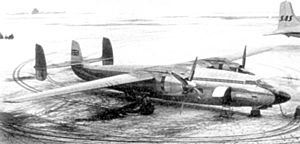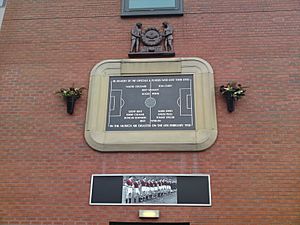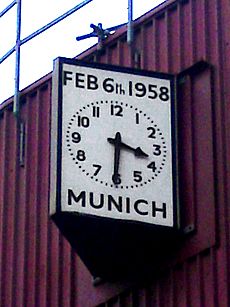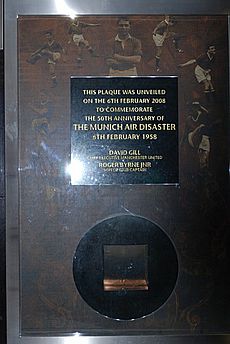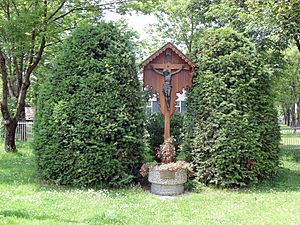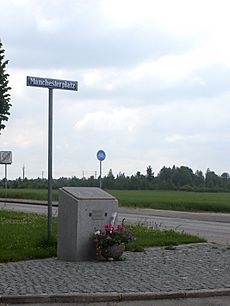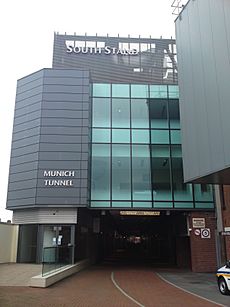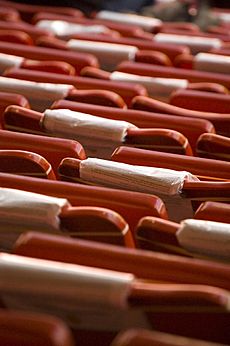Munich air disaster facts for kids

An Airspeed Ambassador similar to the one involved in the crash
|
|
| Accident summary | |
|---|---|
| Date | 6 February 1958 |
| Summary | Take-off failure, slush on the runway |
| Place | Munich-Riem Airport, Munich, West Germany 48°07′34″N 11°40′40″E / 48.12611°N 11.67778°E |
| Passengers | 38 |
| Crew | 6 |
| Injuries (non-fatal) | 19 |
| Fatalities | 23 |
| Survivors | 21 |
| Aircraft type | Airspeed AS-57 Ambassador |
| Aircraft name | Lord Burghley |
| Airline/user | British European Airways |
| Registration | G-ALZU |
| Flew from | Belgrade Airport, Belgrade, SFR Yugoslavia |
| Stopover | Munich-Riem Airport, West Germany |
| Flying to | Manchester Airport, Manchester, England, UK |
The Munich air disaster happened on 6 February 1958. A plane carrying the Manchester United football team crashed. This sad event took place at Munich-Riem Airport in Munich, West Germany.
The plane, British European Airways Flight 609, was trying to take off for the third time. The runway was covered in slush (melting snow). There were 44 people on board, including the famous "Busby Babes" football team. Twenty people died right away. Three more died later in the hospital. In total, 23 people lost their lives, and 21 survived.
The Manchester United team was coming back from a European Cup match in Belgrade, Yugoslavia. They had won their game against Red Star Belgrade. The plane stopped in Munich to refuel. This was because the flight from Belgrade to Manchester was too long.
After refuelling, the pilots, James Thain and Kenneth Rayment, tried to take off twice. They stopped because of engine problems. Pilot Thain decided to try a third time. Snow was falling, making the runway very slushy. The plane hit the slush and could not get enough speed. It crashed through a fence and hit a house. The left wing broke off. The tail broke off and hit a barn, which exploded. Pilot Thain helped people get out of the plane. Goalkeeper Harry Gregg also helped pull survivors from the wreckage.
At first, German airport officials blamed Captain Thain. They said he did not clear ice from the wings. However, later investigations showed the slush on the runway caused the crash. The slush slowed the plane too much. Captain Thain was cleared of blame in 1968. This was ten years after the accident.
Manchester United was a very strong team at the time. They were trying to win their third straight English Football League title. They had not lost a match in 11 games. The crash stopped their title hopes that year. It also destroyed a generation of talented players. It took ten years for the club to fully recover. Manager Matt Busby rebuilt the team. They won the European Cup in 1968 with new players.
The Story Behind the Crash
In 1955, the Union of European Football Associations (UEFA) started the European Cup. This was a competition for the best football clubs in Europe. English teams were not allowed to join at first. However, Manchester United, led by manager Matt Busby, decided to play. They became the first English team in the competition.
The team was known as the "Busby Babes" because they were so young. They reached the semi-finals in their first year. They were beaten by Real Madrid. Winning the English league again meant they could play in the 1957–58 tournament. They were one of the favourites to win.
Playing in Europe meant a lot of travel. Games were on weekdays, and league matches were on Saturdays. Air travel was the only way to play all their games. This was important to avoid proving critics wrong.
United played against Shamrock Rovers and Dukla Prague. Then they faced Red Star Belgrade from Yugoslavia. They won the first game 2–1 in Manchester. The team then flew to Yugoslavia for the second game on 5 February. On the way back from Prague earlier, fog had stopped them from flying home. They had to take a ferry and a train. This trip made the players very tired.
To avoid another difficult trip, the club hired a British European Airways (BEA) plane. They flew directly from Manchester to Belgrade. The match against Red Star ended in a 3–3 draw. This was enough for United to reach the semi-finals. The flight from Belgrade was delayed. Player Johnny Berry lost his passport. The plane landed in Munich, West Germany, at 1:15 PM GMT for refuelling.
The Plane and its Crew
The plane was an Airspeed Ambassador 2. It was six years old, built in 1952. It was delivered to BEA the same year.
The pilot was Captain James Thain. He used to be a flight lieutenant in the Royal Air Force (RAF). He joined BEA after leaving the RAF.
The co-pilot was Captain Kenneth Rayment. He was also a former RAF flight lieutenant. He was a hero from the Second World War. He shot down five German planes. He was given the Distinguished Flying Cross. He joined BEA in 1947.
The Crash Event
Captain Thain flew the plane to Belgrade. But Captain Rayment was flying it back. At 2:19 PM GMT, Munich air traffic control said the plane was ready. They gave permission for take-off until 2:31 PM. Rayment stopped the first take-off. Thain noticed the left engine's power gauge was jumping. The engine also sounded strange.
They tried a second take-off three minutes later. This was also stopped. The engines were getting too much fuel, making them speed up too much. This was a known problem for this type of plane. After the second try, passengers went back to the airport lounge. It started snowing heavily. It looked like the plane might not fly that day. Player Duncan Edwards even sent a telegram saying flights were cancelled.
Thain told the engineer about the engine problem. The engineer suggested keeping the plane overnight. But Thain wanted to stay on schedule. He thought trying to speed up the engines more slowly would work. This meant the plane would need more runway to take off. But the runway was almost 2 kilometres long. He believed it would be fine. The passengers were called back to the plane.
Some players were nervous about flying. Billy Whelan said, "This may be death, but I'm ready." Others, like Edwards and Tommy Taylor, moved to the back of the plane. They thought it would be safer there. At 2:56 PM, the plane started moving again. At 2:59 PM, they got permission to line up for take-off. At 3:02 PM, they were told their take-off time would expire at 3:04 PM. The pilots decided to try again. They would watch the engines carefully.
Rayment slowly moved the throttle forward. The plane started to speed up. Radio officer Bill Rodgers told the control tower, "Zulu Uniform rolling." The plane kicked up slush as it gained speed. Thain called out the speed. At 85 knots, the left engine surged again. Thain pulled back slightly on the throttle, then pushed it forward.
When the plane reached 117 knots, Thain said "V1". This meant it was too late to stop the take-off safely. Rayment waited for "V2" (119 knots), the speed needed to lift off. But the speed stayed around 117 knots. Then it dropped to 112 knots, and then 105 knots. Rayment shouted, "Christ, we won't make it!" Thain looked up to see what was ahead.
The plane skidded off the end of the runway. It crashed through a fence and across a road. Its left wing was torn off when it hit a house. A family lived in the house, but the mother and three children escaped. Part of the plane's tail broke off. The right side of the plane hit a wooden hut. Inside was a truck full of tyres and fuel, which exploded.
Thain saw flames near the cockpit. He feared the plane would explode. He told his crew to get away. The stewardesses, Rosemary Cheverton and Margaret Bellis, escaped through a broken window. Radio officer Rodgers followed. Rayment was stuck in his seat. Thain climbed out a window. On the ground, he saw more flames. He went back into the plane to get fire extinguishers.
Meanwhile, in the cabin, goalkeeper Harry Gregg woke up. He thought he was dead. He felt blood on his face. He saw light shining into the cabin. Gregg kicked the hole wider and escaped. He also saved teammates Bobby Charlton and Dennis Viollet. They were still strapped into their seats.
People Affected by the Crash
Twenty people died at the crash site. One more died on the way to the hospital. Two others died later in the hospital.
People Who Died
Crew Members
- Captain Kenneth Rayment. Co-pilot. He survived the crash but died three weeks later from brain damage.
Passengers
Manchester United Players
- Geoff Bent
- Roger Byrne
- Eddie Colman
- Duncan Edwards (He survived the crash but died in hospital 15 days later)
- Mark Jones
- David Pegg
- Tommy Taylor
- Billy Whelan
Manchester United Staff
- Walter Crickmer, club secretary
- Tom Curry, trainer
- Bert Whalley, chief coach
Journalists
- Frank Swift, News of the World (He was also a former England and Manchester City goalkeeper. He died on his way to hospital)
- Donny Davies, retired footballer, who wrote for the Manchester Guardian
People Who Survived
Crew
- George William "Bill" Rodgers, radio officer (died 1997)
- Captain James Thain, pilot (died 1975)
Passengers
Manchester United Players
- Johnny Berry (He never played football again, died 1994)
- Jackie Blanchflower (He never played football again, died 1998)
- Bobby Charlton
- Bill Foulkes (died 2013)
- Harry Gregg (died 2020)
- Kenny Morgans (died 2012)
- Albert Scanlon (died 2009)
- Dennis Viollet (died 1999)
- Ray Wood (died 2002)
Manchester United Staff
- Matt Busby, manager (died 1994)
Journalists and Photographers
- Frank Taylor, News Chronicle reporter (died 2002)
Understanding the Crash Cause
The crash was first thought to be the pilot's fault. But later, it was found that slush on the runway caused it. The slush slowed the plane down. It could not reach the speed needed to fly safely. During take-off, the plane reached 117 knots. But in the slush, it dropped to 105 knots. This was too slow to leave the ground. There was also not enough runway left to stop.
Older planes were not as affected by slush. But newer planes, like the Ambassador, were more vulnerable.
German airport officials took legal action against Captain Thain. He was the only pilot who survived. They claimed he took off without clearing ice from the wings. They said this caused the crash. However, many witnesses said there was no ice. Clearing ice was the captain's job. But the airport was responsible for the runways. Many airport staff did not know how dangerous slush was for planes like the Ambassador.
The German case relied on the wings being icy hours after the crash. They also used a photo taken before take-off. This photo seemed to show snow on the wings. But when the original photo negative was checked, there was no snow or ice. The "snow" was just sunlight reflecting off the wings. The witnesses were not called to the German inquiry. The case against Thain lasted until 1968. He was finally cleared of any blame. British officials said the cause was melting snow on the runway. This stopped the plane from reaching take-off speed.
Captain Thain was fired by BEA after the accident. He never worked for them again. He retired and ran a poultry farm. He died in 1975 at age 53.
What Happened After the Disaster
Twenty people died at the crash site. Seven of them were Manchester United players. The 21st victim was Frank Swift, a journalist. He died on his way to the hospital. Duncan Edwards died from his injuries on 21 February. Co-pilot Rayment died later from head injuries. This brought the total to 23 deaths.
Johnny Berry and Jackie Blanchflower were badly hurt. They could never play football again. Manager Matt Busby was also seriously injured. He stayed in the hospital for over two months. He almost gave up football. But his wife, Jean, told him the players would have wanted him to continue. This helped him recover. He returned to Manchester and watched his team play.
Many thought the club would close down. But a small United team finished the 1957–58 season. Matt Busby's assistant, Jimmy Murphy, became manager. He was not on the flight. He was managing the Wales team in Cardiff.
The team was mostly made up of reserve and youth players. They beat Sheffield Wednesday 3–0 in their first match after the disaster. The match program had blank spaces for the United players' names. Only Harry Gregg and Bill Foulkes were fit to play from the survivors. United needed experienced players. Murphy signed Ernie Taylor and Stan Crowther. Three non-league players also joined on short contracts. Only Warren Bradley signed a permanent contract. Reserve players like Shay Brennan filled the remaining spots. Even rivals Liverpool offered to loan players to help United.
Changes also happened behind the scenes. Secretary Walter Crickmer and coaches Tom Curry and Bert Whalley died. Goalkeeper Les Olive became the new club secretary. Former United goalkeeper Jack Crompton took over coaching duties.
United only won one more league game that season. Their title challenge ended. They finished ninth in the league. They reached the FA Cup final but lost to Bolton Wanderers. They also beat Milan at home in the European Cup semi-finals. But they lost badly in the away game. Real Madrid, who won the trophy, suggested United be given the trophy that year. But this did not happen.
Busby returned as manager the next season. Real Madrid offered to loan Alfredo Di Stefano, a famous player. But the English FA stopped the transfer. Instead, Madrid raised money and played friendly matches with Manchester. Busby then built a new team. This team included George Best and Denis Law. Ten years later, in 1968, they won the European Cup. Bobby Charlton and Bill Foulkes were the only two crash survivors in that winning team.
A fund was set up for the victims' families. It raised £52,000 by October 1958. In 1963, Manchester United settled a legal case against BEA. The amount was not made public.
Remembering the Disaster
Old Trafford Memorials
The first memorials at Old Trafford were put up on 25 February 1960. One was a plaque with the victims' names. It was placed above the directors' box entrance. Above it was a carving of a player and a supporter. Matt Busby unveiled this plaque.
A bronze plaque for the journalists who died was also unveiled. Crash survivor Frank Taylor unveiled it. This plaque was stolen in the 1980s. A new one is now in the press entrance.
The "Munich clock" was also put up. It is a simple clock on the stadium's southeast corner. It has "6 Feb 1958" at the top and "Munich" at the bottom. It is still there today.
When the stadium was changed in the 1970s, the first plaque had to be moved. A new, simpler memorial was made in 1976. A third version, more like the original, was installed in 1996. This was when a statue of Matt Busby was also put up. The third plaque and Busby's statue were moved in 2000.
Munich Memorials
There are also two memorials in Germany. One is a small wooden cross in Trudering, a Munich suburb. It has a plaque remembering the victims of the crash. It also remembers all traffic victims from the area.
On 22 September 2004, a new granite plaque was unveiled. It is near the old Munich Airport. It looks like a football pitch. It says, "In memory of all those who lost their lives here in the Munich air disaster on 6 February 1958." Manchester United paid for this memorial. Club officials and survivor Sir Bobby Charlton attended the unveiling. In 2008, the Munich city council named the area "Manchesterplatz" (Manchester Square).
On the 57th anniversary in 2015, Sir Bobby Charlton and FC Bayern Munich chairman Karl-Heinz Rummenigge opened a new museum exhibit. It is at Bayern Munich's stadium, the Allianz Arena.
Belgrade Memorials
At the Majestic Hotel in Belgrade, there is a small display. It has items from the team's stay. These include a menu signed by 14 players, including those who died. There is also a photo and a match ticket. The piano played by player Mark Jones the night before the crash is also there.
Anniversary Events
In 1997, former player John Doherty asked for a special match. It would be for the victims and survivors of the disaster. A benefit match was planned for the 40th anniversary. Fans bought tickets even before the opponent was decided.
Former United player Eric Cantona wanted a farewell match. So, the two events were combined. The match was held on 18 August 1998. Cantona played for a European XI team. United won the match 8–4. This match raised £47,000 for each victim's family.
On 7 February 1998, United played Bolton Wanderers. This was a day after the 40th anniversary. The game started later to allow a minute's silence. Representatives from both teams laid flowers. Survivor Bobby Charlton led the teams out.
50th Anniversary
A memorial service was held at Old Trafford on 6 February 2008. This marked the 50th anniversary. The surviving team members were guests of honour. The tunnel under the stadium's South Stand was renamed the "Munich Tunnel." It has an exhibition about the Busby Babes.
On the same day, the England national football team played Switzerland. Pictures of the lost players were shown. England players wore black armbands. A minute's silence was held. It was mostly respected by fans.
At the derby match between United and City on 10 February 2008, both teams honoured the victims. Managers Sir Alex Ferguson and Sven-Göran Eriksson laid wreaths. A minute's silence was held and respected. Both teams wore special kits and black armbands. Fans were given commemorative scarves.
Tributes and Legacy
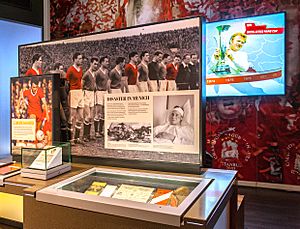
Music Tributes
Many songs have been written about the Munich air disaster. One of the earliest was "The Flowers of Manchester." It was recorded by the band The Spinners in 1962. Singer Morrissey released a song called "Munich Air Disaster, 1958" in 2004. The English band The Futureheads named their album News and Tributes after the disaster. The title song honours those who died.
Film and TV Stories
There have been plans for a Hollywood film about the crash. Survivors were worried about how accurate it would be. Harry Gregg was concerned about how the players would be shown.
In 2006, the BBC showed a documentary called Surviving Disaster. It told the story of the crash. Some former players said it had mistakes.
On the 50th anniversary in 2008, many TV channels showed programs. MUTV aired "Munich Remembered." The BBC showed a documentary following Harry Gregg. He went back to Munich and met rescuers. He also met Vera Lukić, a pregnant woman he rescued, and her son Zoran.
In 2011, the BBC made a TV film called United. It told the story of the crash and rebuilding the team. It focused on coach Jimmy Murphy. The film got good reviews. But Matt Busby's son said it was "very poorly done." The Canadian TV series Mayday / Air Crash Investigation also covered the crash in 2011.
Other Memorials
The University of Salford named a student hall after victim Eddie Colman. He was born in Salford. There are also small roads in Newton Heath named after the players who died. These include Roger Byrne Close and Duncan Edwards Way. An old people's home is named after Duncan Edwards. The road bridge over the Luas tram line in Dublin is named after Billy Whelan.
See also
 In Spanish: Desastre aéreo de Múnich para niños
In Spanish: Desastre aéreo de Múnich para niños
- History of Manchester United F.C. (1945–69)
- List of accidents involving sports teams


